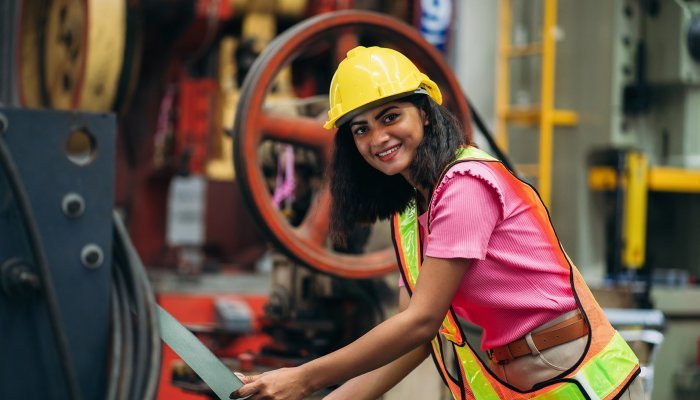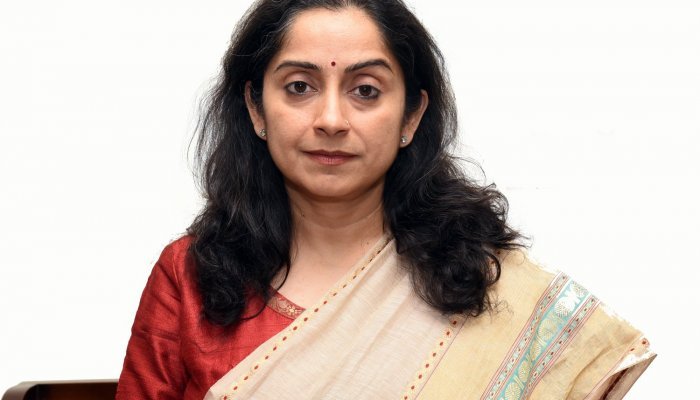India’s growth story
In 1991, India started to dismantle the licence and permit system that had dominated its economy up until then. This system inhibited growth as businesses required a licence from the government to operate, which was notoriously difficult to obtain. With the rules changing, the Indian economy embarked on its current growth trajectory. However, it was only when the government started to transform core sectors of the economy, such as energy and telecommunication, in the early 2000s that the economy really started to take off, and gross domestic product (GDP) numbers began to improve exponentially.
While economists understand that GDP is an important indicator, they are careful not to become fixated on it. As a country’s GDP does not exist in a vacuum, economists know that they also need to consider the population’s quality of life. They do that by referring to the human development indicators (HDI). If you look at India’s evolution in terms of its HDI, you realise that while the country may be 20 years behind China in terms of GDP, it is only six to eight years behind it in terms of its HDI.
The reason for this is that, unlike China, India is a democracy. And for India, if political parties want to win elections, not only at national or state level but also at the village polls, there has to be a notable focus on development.
This is where India’s story gets interesting. As every government and every major party in the country has to showcase economic development, this immediately puts the focus on dealing with poverty. When we look at how India is doing in terms of the United Nations Sustainable Development Goals (SDGs), which all translate into a better life for ordinary citizens, the data reveals that India is outperforming its peers like Brazil and South Africa. While these two countries have a higher GDP per capita than India, they are likely to miss their SDG goals with regards to poverty alleviation, especially after the Covid-19-pandemic shock.
India’s data in a nutshell
The UN’s number one SDG is to reduce poverty to below 3% of its total population. When measured in terms of this goal, we see that India has effectively eradicated extreme poverty, as our standard metrics indicate it currently does fall below 3%. This is a monumental achievement for a country that is so diverse, complex, and extremely poor. When we look at a metric called multidimensional poverty – which measures access to health, education, and housing – we can see that India has lifted almost 250 million people out of extreme poverty since 2016. Regardless of which metric you consider, a consistent story emerges: Indians are now less poor.
When we look at other metrics that give an indication of people’s quality of life, we also see improvements. For example:
- India has reduced its maternal mortality rate at nearly twice the speed of the global average over the last 10 years.
- India’s infant mortality rate, which looks at the number of children who die under the age of five, is falling in every state of India, and not just in the fastest-growing or richest states.
- Since 2016, crime against women has also fallen, especially incidents of rape. Research shows that this can be directly attributed to the 120 million toilets that were built across the country. The building of these toilets had a direct impact on the safety of women because, in the past, women needed to go outside in the dark to do their ablutions. In just two years, having toilets saw a 22% reduction in assaults on women and a 14% reduction in rape.
- Episodes of rioting have also fallen. In the late 1980s, India experienced more than 100 000 riots a year. Now, the data shows that India has fewer than 30 000 riots per year. While this number is still high, it must be remembered that India has a population of 1.4 billion people. This drop in the number of riots clearly indicates that India is a far more peaceful country than it has been over the last 50 years.
Atmanirbhar Bharat
Economic growth is non-negotiable for India, which is remarkably different from the popular talk of ‘de-growth’ across several developed countries, for example in Europe. Following the Covid-19 pandemic, the US-China trade war and the subsequent disruptions in the global supply chain, India started to rethink its industrial and long-term manufacturing policies. This is when the concept of Atmanirbhar Bharat emerged, which translates to ‘self-reliant India’.
However, Atmanirbhar Bharat is not about India becoming autarkic or inward-looking to the exclusion of the global community; it is not like ‘Make America Great Again’. There is widespread awareness that globalisation has benefited India greatly. As such, self-sufficiency is not about excluding global partners. In fact, India is still forging stronger links with the global economy and is entering free-trade agreements and bilateral trade agreements with many countries, the pace of which has picked up over the last five years.
There is, however, a strategic push towards self-sufficiency in certain key sectors, such as pharmaceuticals, food, and energy. And this is paying off. India currently produces 126% of its food requirements, which means it is producing more than what is consumed. In addition, in the past, the country’s food imports stood at around 33% of its total imports, whereas now this figure is down to 2%. (It will never be zero because affluent Indians will continue to consume global food products that are not produced locally.)
Another key sector for the economy is energy security. The country’s continued growth means that its energy requirements are going to escalate, and its dependence on energy imports will continue. Currently, India imports about 33% of its total energy requirements. This is strategically unsustainable.
Moreover, India’s growth path has to be different from the paths of the richer countries of today. The countries that became rich before us did so on the back of polluting growth strategies. Indian growth needs to be more responsible, with climate change being of great global concern. As such, India is consciously trying to be more environmentally responsible, which explains the major push towards renewable energy in the country.
There is also a major push to reinvigorate manufacturing in India. This is inextricably linked to job creation. Now, as China is losing its cost advantage in the form of an ageing labour force, and there is a geopolitical realignment away from China, a window of opportunity has opened up for India to attract large global manufacturers. In addition, as the rest of the world grows – Latin America, Africa, South Asia – the demand for simple manufactured items will continue to expand. India’s manufacturing policy is geared to capture this growing segment.
Over the last 10 years, India has reinvigorated its industrial policy, which has seen a huge amount of capital expenditure on expanding and improving infrastructure. This is across the country and not merely focused on a few special economic zones.
Technology is a key driver
Today, almost every Indian has a bank account, an electronic/digital identification number and mobile phone connectivity. This trinity of bank account, biometric ID and mobile engine has allowed the massive digitisation of the Indian economy, which has boosted efficiencies and resulted in tectonic shifts across the economy.
One example of this was seen in the distribution of social welfare. In the past, India was spending three rupees to distribute a single rupee of welfare to a beneficiary. This was the cost of corruption and leakages. However, with nearly everyone having a bank account and mobile phone, direct benefit transfers have become the new normal. Immediately, targeting errors fell to near zero, and the incidence of leakages plummeted. The net effect of this is that India is saving 1.5% of its total GDP due to a more efficient welfare system. It has also become far more equitable, with the most deserving receiving benefits in real time.
Another remarkable story is the impact technology has had on Indian start-up businesses. Today, some of the fastest-growing sectors in India include the e-commerce space – agricultural tech, education tech and health tech, among others. Young Indians are using digital technology to start and grow different kinds of businesses across sectors and regions. This is emphasised by the fact that India has produced 114 unicorns since 2011. The country is seeing major growth in the start-up sector primarily because the core digital infrastructure is universally available across the population.
This start-up trend also reflects the country’s consumer sentiment. In the past, there was a greater emphasis on getting stable government jobs or secure corporate jobs. Today, for the first time in 75 years, self-employment is rising, and this has to do not only with the leveraging of technology but also with growing optimism in the economy.
Digitisation has also offered a significant avenue for strengthening cooperation with other countries. India has used digitisation to implement several successful public schemes, like the welfare system. Dozens of countries have expressed interest in adopting similar digital public infrastructures with India’s support.
Beyond GDP numbers
India’s real success story, however, is how its economic growth and government policies are transforming the lives of ordinary citizens on the ground. Through a policy of saturation, India is trying to ensure that all citizens, everywhere in the country, have access to basic amenities, including electricity, bank accounts, mobile phones, piped drinking water, LPG or cooking gas, and toilets.
Independent surveys, such as the National Family Health Survey, which surveyed 1.2 million people over the last seven years, revealed that in 2015, only half of the poorest 20% of the population said they had electricity. Today, electrification is nearly universal. Toilets and piped drinking water offer a similar story, as does access to bank accounts, with 95% of the population being banked. Post the pandemic, access to free food grains is ensured for 60% of the population.
Healthcare has also been improved for the poorest members of society through the expansion of the world’s largest publicly financed health insurance scheme. Today, the out-of-pocket health expenditure burden has fallen below 40% for the average Indian. It used to be nearly 70% just six years ago. As such, poor people can now seek healthcare from in-patient hospitalisation, where previously they could not afford it. This has been a major step towards universal healthcare access in India.
India’s welfare initiatives feed directly into its growth strategy by taking care of basic needs like food, electricity, connectivity, and healthcare. These amenities significantly enhance human productivity. It is laying the groundwork for enhanced human capital and economic growth for the next 100 years.
Success through the localisation of solutions
Across India, more than 10 of our 28 states have already achieved the UN SDGs, for instance in the reduction of the infant mortality rate, neonatal mortality rate, and maternal mortality rate.
This mandates a movement towards precision policymaking, which means development solutions have to be customised to local needs. The aspirational district programmes focused on the poorest 120 districts of the country have seen successful outcomes. Now, there’s a movement towards aspirational blocks, which is an even more granular programme.
To gauge India’s economic growth in real time, economists study different modern datasets. One example is the daytime satellite imagery data from the Global Human Settlement Layer. It shows that India’s growth has been 18% higher in the past ten years than it was in the previous decade. Precision policymaking has ensured that India’s remotest rural areas are also growing. India is connecting remote areas through road infrastructure, electricity, piped water, affordable housing, and technology. So, while there is still a lot of variation in the country, we are seeing more balanced growth than before and, as such, a reduction in economic inequality across geographies.
This more granular approach has also revealed that labour participation rates are growing for all demographic segments, including women. Historically, India has struggled with low participation of women in the labour force. It is still only half that of men, because India is still a very traditional society and women face many hurdles in accessing labour markets. This includes family expectations of daily chores and caregiving. The reality is that women are still responsible for most household chores and caregiving of both children and the elderly in the family.
One initiative that India is rolling out is the building of care infrastructure across the country as a means of giving women more choices. Building of the care economy is critical because women are doing extremely well academically. There are more women in educational institutions of higher learning, such as colleges and universities, and 45% of engineers and STEM (science, technology, engineering, and mathematics) graduates are women. But when it comes to participation in the workforce, that number falls to less than half of that of men. This care infrastructure will ease the burden on women and give them greater choice in the labour market.
India’s success is also a remarkable gender story
In this story of India, there has to be a discussion on the subject of women-led development. India appears to be in the middle of a virtuous cycle where more and more women are voting. In fact, more women in India vote than men, not just at the national level but also at the state level and in local elections. As a result, every political party and every government has women as a core focus. Even those political parties who were traditionally against the reservation of some political seats for women are avid supporters today. It is a story of democracy in action: women’s empowerment and women’s development cannot be ignored by any party. And that is why ‘women-led’ is a term that is often used in India’s policy decisions.
In addition, more women are participating in government. More than half the heads of village organisations, nearly 150 000 village heads, are women. India has seen a 16-fold increase in the number of women contesting elections, and the percentage of them winning is starting to increase. This will eventually bubble up to the parliament level where India currently has only 12% female parliamentarians. However, from 2029 onwards, the Women’s Reservation Bill requires 33% of parliamentarians to be women. India’s bottom-up approach to the political empowerment of women has ensured the creation of a robust pipeline of women leaders. It is a wonderful story of self-empowerment and what women are trying and capable of doing to transform their lives, and India.
The increased political status of women is having an immediate positive influence on India’s democracy and its economy, which continues to grow at an unprecedented rate and transform the standard of living for all its citizens.
KEY TAKEAWAYS
- India is experiencing exponential economic growth and is also improving the lives of its citizens dramatically.
- While its per-capita GDP is lower than its peers, India has emerged as the fastest-growing major economy in the world and is touted to become the third-largest in five years
- India’s commitment to providing basic amenities to all its citizens is not only about improving their lives; it is also about the country’s long-term economic sustainability: healthy, happier people are more productive.
- Technology has transformed India’s economic landscape by improving efficiencies and creating a more entrepreneurial culture.
- India’s localised policies, which are a result of a robust democratic process, are helping to uplift remote rural areas.
- Women in India are driving changes in their lives and transforming society through active participation in the democratic process.
Dr. Shamika Ravi is a member of the Economic Advisory Council to the Prime Minister and Secretary to the Government of India. Over the last twenty years, she has taught in postgraduate programmes across India, including The Indian School of Business and the BITS School of Management, where she teaches managerial economics, game theory, and microfinance. Dr. Ravi has a PhD in Economics from New York University.







